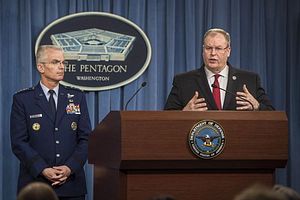The U.S. Department of Defense (DoD) is seeking $71.8 billion in its fiscal year (FY) 2017 budget request for research and development, including $3.6 billion dedicated to war-gaming and testing the Pentagon’s so-called third offset strategy developed to help maintain U.S. military superiority over peer competitors such as China and Russia.
According to information obtained by Defense News, the Pentagon has dedicated $18 billion in its Future Years Defense Program (FYDP) to researching and developing third offset technologies and operational concepts in the years to come.
Money allocated includes $3 billion on researching Anti-Area/Access-Denial (A2/AD) technologies, $3 billion on submarine and undersea challenges, $3 billion on human-machine collaboration and teaming, $1.7 billion on cyber and electronic warfare, $500 million on guided munitions challenges, and $500 million on wargaming and the testing of third offset operational concepts.
With $71.8 billion, the FY 2017 budget request is just four percent higher than the $69 million allocated for research and development in FY 2016. U.S. Deputy Secretary of Defense Robert Work already cautioned in December 2015 not to expect a massive increase in funds allocated towards third offset technologies and operational concepts.
Back in December, Work revealed that the Pentagon’s third offset focus in FY 2017 will be on autonomous deep learning machines and systems to strengthen the Pentagon’s analysis capability; human-machine collaboration to support decision making processes; assisted-human operations in order to help humans operate more effectively on the battlefield through new technologies like exoskeleton suites; advanced human-machine teaming where soldiers work with unmanned platforms; and semi-autonomous weapons systems.
However, the third offset strategy will not merely rely on new military technologies to guarantee military superiority in a future conflict but also focus on merging new with legacy technology, as well as new with old warfighting methods. As I explained previously (See: “No More Easy Victories for the US Military?”), a third offset strategy could include robot weapons and remote-controlled warfare on the one hand, as well as conventional military hardware, like the new M109A7 Paladin (see: “The US Army’s Deadly New Gun”) – capable of firing precision munition, on the other hand.
“As competitors seek to reduce our technological advantage, DoD will accelerate adoption of advanced capabilities that offset adversary investments, reshape the nature of international military competition, and cost-effectively extend the U.S. advantage while imposing cost on our competitors,” notes a FY 2017 budget request factsheet published by the Pentagon.
There is little doubt that the Pentagon’s third offset strategy primarily aims to offset recent advances in military technologies made by China and Russia. The Pentagon lists both countries as two out of five strategic challenges that the United States will have to remain focused on in the new fiscal year.
The new defense budget request “responds to Chinese military modernization by taking prudent steps to preserve and enhance deterrence for the long term, including through targeted investments in emerging capabilities to sustain our military edge in the Asia-Pacific,” the Pentagon fact sheet reads.
“With regard to Russia, Countering Russian offensive capabilities through prudent, targeted investments in emerging capabilities today to ensure that we will retain our conventional superiority over near-peer competitors such as Russia for decades to come,” according to the fact sheet.
While the Pentagon’s third offset strategy is not just about countering Russian and Chinese military technological capabilities, both countries nevertheless will remain the proving ground for any new concepts given their relative technological lead over other competitors such as Iran and North Korea in the military field. During the presentation of the FY 2017 defense budget request on February 9, Work noted that is will be prudent for the Pentagon to “be prepared for a period of increased competition over the next 25 years” with both countries.
































